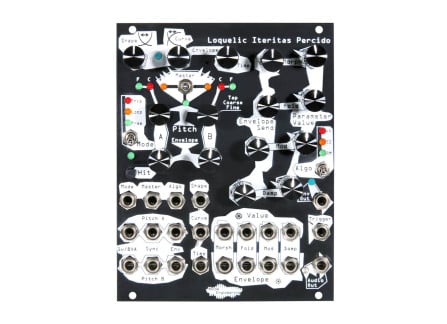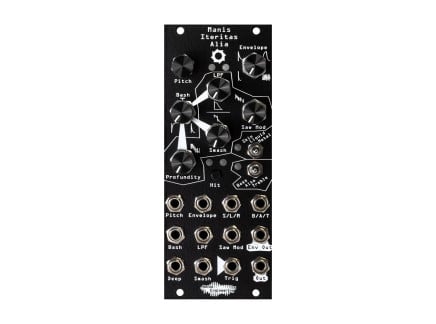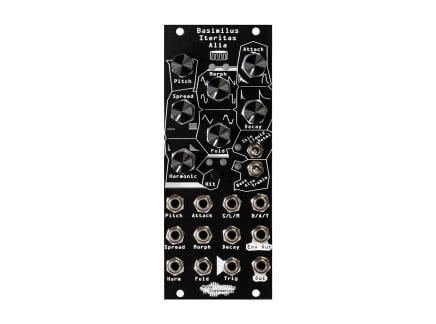Modular synthesis exploded over the past decade. I’m not going to pretend to be one of the old guard: I didn’t spend the 2000s or early 2010s in front of an all-Doepfer rack waiting with baited breath for the rest of the world to catch up. I, like many others, got into Eurorack because I heard about a module that could do crazy stuff and looked crazy cool.
The particular module that jogged my interest was the Mutable Instruments Rings, but there’s more than one path into modular. Well, there are usually about four or five paths, namely a handful of modules either introduced in the past 10 years or that had their first version introduced in the past 10 years which still dominate the modular market today. Make Noise Maths, ALM Busy Circuits Pamela’s Workout, and Mutable Instruments Plaits are numbers One, Two, and Four respectively in Reverb’s Best-Selling Modular Synths category. But who’s that Number Three spot?
None other than the nasty, amazing, and inimitable Noise Engineering Basimilus Iteritas Alter. Any modular Mount Rushmore is absolute poppycock without featuring this monochrome monster in its ranks. Born from the minds of two music and engineering nerds who would eventually become married music and engineering nerds, the Basimilus Iteritas Alter (hereafter referred to by its initialized moniker “BIA”) is the cornerstone of one of the most beloved synth module families of all time.
And now, it’s time to say adieu to four of those family members. In an article titled Fare thee well, sweet Basimilus posted to their blog on August 15th, Noise Engineering announced the discontinuation of the BIA, Manis Iteritas, Cursus Iteritas, and Ataraxic Iteritas. As the type of modules to which people develop an emotional attachment, the response was pretty loud. All four immediately became collector’s items. Fans lamented their demise on Reddit. Someone wrote a “love song” to the BIA.
Musicians obsessing over their gear is only part of why we’re here today. How did the Iteritas family happen? What are all of the modules in the family and what do they do? What is Noise Engineering going to make to replace these heavy hitters? Let’s take a look at how the Iteritas came to be, how it reigned in the modular world, and what may rise from its ashes to sit upon the mighty Throne of Bleeps and Bloops.
Origin
Noise Engineering is two people at its core, Stephen McCaul and Kris Kaiser. They met in 2007: Stephen was an audio engineer in the video game industry and Kris was a biology professor with a focus in frogs and bioacoustics. They married after being friends for a few years, and one day Stephen started poking around designing a Eurorack module after a friend built a system. He created a module which was meant for the friend, but ended up becoming one of Noise Engineering’s first designs.
Soon, a few other designs came along—and among those early designs was the forebear to the Iteritas line: the Basimilus Iteritas. Eventually, Basimilus Iteritas's design was revised, giving us the now-famous Basimilus Iteritas Alter. We’ll get into its design and sound in a bit, but what’s important right now is the actual hardware.
[Above: Images of the original version of Basimilus Itertias.]
For a burgeoning modular synth company, locating a reliable and affordable source for parts is a key factor in whether or not that company will become successful. Think about the effect pedal world: throw a rock and chances are you’ll come across marketing material that waxes long on New Old Stock diodes, discontinued bucket brigade chips, or a special silicon transistor that will rip your face off and serve it to you on a silver platter.
I’m having a little fun with it, but in candor, builders are obsessed with locating and sourcing parts for their creations, and for good reason. Whether it’s the functionality of a component, its particular size for a specific build, the sound it imparts, or a combination of the three, these vital pieces take on the role of lifeblood for smaller companies without established manufacturing verticals or the longer reach of larger companies.
For Noise Engineering, that bit of lifeblood was a specific processor produced by a company called XMOS. The world of processors is and was a vast and wild one, especially back in the early 2010s when Stephen began plotting what would become the Basimilus Iteritas. In Noise Engineering’s own words from their discontinuation announcement, Stephen was “both new to the world of embedded CPUs and opinionated about what he needed in a processor”. With XMOS, Stephen and company found an affordable processor with the brawn required to act as the shiny new brain for Noise Engineering’s shiny new monster oscillators.
So then: why were the core members of the Iteritas series discontinued? Namely because the XMOS processors used in their construction are being discontinued, but a departure from the norm was a long time coming. While these specific processors fit the bill for what Noise Engineering wanted in the early 2010s, the scope and shape of module design and capability made leaps and bounds in the ensuing decade. Point in case: module lines with user-updatable firmware like the Legio and Versio series, a feature markedly lacking in the formidable Iteritas. However, because of all the other boxes the processor checked, Noise Engineering stayed the course, even knowing that the XMOS processor would eventually reach end-of-life (EOL).
Earlier this year, they finally received the EOL notice from XMOS and on August 15th, Noise Engineering announced the discontinuation of the four core Iteritas models on their blog. So then: what did NE leave behind, and what could possibly be on the horizon to replace these beloved oscillation behemoths? Let’s take a look at the design and philosophy behind the Iteritas family, examine each of its members, and marvel at the recently-announced successors to this iconic family: the three Alia oscillators.
The Iteritas Family
Basimilus Iteritas (Original)
“Analog inspired parametrized digital drum synthesizer.” It’s one of those descriptions that excites and entices while remaining mysterious enough to make you start digging for more. Born from a desire to emulate the richly organic sound of classic analog drums, the Basimilus Iteritas is the grandaddy of the line and the basis of all that came after.
At the BI’s core is a seven-oscillator architecture of six tonal oscillators and a noise oscillator. Each oscillator features its own envelope controlled by the Attack, Decay, and Harm controls (more on those momentarily).

They can be arranged in two configurations: Skin, an additive synthesis mode, and Metal, which employs FM synthesis. Skin establishes one oscillator as the fundamental (the one receiving the pitch) and uses the remaining oscillators as harmonic multiples to emulate the frequency response of harmonic instruments like bass drums and toms. For more inharmonic instruments like cymbals and bells, the Metal mode’s FM synthesis schematic modulates the oscillators by each other to create the harsher and more abrasive sounds of, well, metal. In both instances, the sum of the oscillators is fed into an attack envelope, then the extra-fun wavefolder, and finally a decay envelope.
The nine parameters are remarkable because they seem like a lot to handle but aren’t overwhelming in practice. Pitch controls the pitch of the fundamental oscillator; Attack and Decay control the AD envelopes on each oscillator; Morph alters the waveform, blending sine, triangle, saw, and square; Fold controls the wavefolder’s number of fold stages and pulse; Skin and Metal were already discussed; Bass/Treble alters the frequency range; and finally, Harmonic controls the harmonic decay of the oscillators and Spread controls their frequency spacing in relation to the fundamental.
Presto: with a few minutes of orientation, anyone with a basic knowledge of modular synthesis can summon jangly, pulsing, thick, and complex synth sounds which continually interact and evolve. Thanks, Noise Engineering!
Loquelic Iteritas
The next entry in the series came with the Loquelic Iteritas, a complex oscillator released in 2014. With Loquelic, Noise Engineering was free to incorporate more of the synthesis techniques they had researched, combining three distinct algorithms with a dual-oscillator design.
According to its manual, the Loquelic Iteritas “is about continuous tone control”, and its efficient interface reflects that philosophy. Coarse and Fine pitch knobs for both A and B oscillators take up the top third of the module, and the remaining space hosts in/out jacks, an oscillator switch, and four CV-controllable parameters. Morph shifts the waveform between sine, triangle, and saw; Fold handles the threshold of the wavefolder; Mod controls the phase modulation between the two oscillators; and Damp varies between the modes, but in general controls decay/harmonics.
Loquelic's four parameters and multiple novel synthesis algorithms are the secret sauce for the dizzying array of sounds available in this module. “VO” is Noise Engineering’s take on VOSIM synthesis, exponentially modulating the frequency of the carrier to create wildly complex harmonics; “SS” approximates summation synthesis which achieves a shrill but harmonically rich result; and “PM” recreates phase modulation synthesis for an even broader palette of exotic tone.
Happily, the Loquelic Iteritas survived the discontinuation of the other members of the Iteritas family—and as of the time of publishing this article, it is still readily available.
Basimilus Iteritas Alter
No one ever sees it coming when the second album outshines the debut album, but the BIA is one of the most celebrated modules of all time. It’s the basis for countless rigs and responsible for more of the sweaty, ominous scores in film and television than you think. It’s one of the GOATs, and it’s the core of the Iteritas family.

The three clutch changes that made the Alter a juggernaut illuminate the thought and creativity put into Noise Engineering’s designs. They added an “Alto” range to Bass/Treble switch, a “Liquid” mode (six-oscillator additive synth with a pitch envelope) to the Skin/Metal mode switch, and created CV jacks for the switches (brilliant). As an added bonus, they made the BIA 2HP smaller than its predecessor.
The increase in harmonic range and modes coupled with the switches operating on controlled voltage transformed the Basimilus Iteritas into a true industrial shapeshifter. If you’re unfamiliar with everything the BIA can do, hop on YouTube and watch it patched up and in action (we have plenty of videos). It’s not uncommon for sound designers to use the BIA as a one-stop sample shop of kicks, snares, alien cymbals, and snarling synth, but it’s also impossibly fun to just patch it to the nines and marvel at the sonic kaleidoscope that spills out.
Cursus Iteritas
With a proof of concept that captured more arcane synthesis techniques in an intuitive physical rendering, Noise Engineering turned their sights to another exciting technique: wavetables. The Cursus Iteritas married the wide-open possibilities of a dynamically-generated wavetable with the monster CV modulation opportunities of the Iteritas family.
Combined with three modes with distinct approaches to frequency named after their inventors (Daubechies, Fourier, Walsh), the Cursus Iteritas boasts nine tweakable parameters like its rowdy drum cousin, the BIA. However, the Cursus controls are built for quick and simple edits to the module’s complex wavetables. Pitch naturally controls the frequency; Center selects the fundamental harmonic of the wavetable; Structure decides the number of harmonics included in the output; Edge controls wavetable oversampling; Fold is for the wavefolder; Width selects the number of harmonics included in the wavetable; and finally, Tilt allows more emphasis to be placed on higher or lower harmonics.
Manis Iteritas
Though the Basimilus Iteritas Alter is a beastly module by the measure of most, there are some who need even more bite. What better way to get more teeth than to add more sawtooth? The Manis Iteritas juiced up the already industrial-powered BIA by replacing every bit of sine wave with sawtooth and running it through a reconceived interface built to make destructive sounds.
The souped-up interface revolves around the Smash function, which routes an AD envelope to the LPF, Profundity (chorus/detune), Smash (wave destroyer), and Saw Mod (pulse width modulation). Like its kin, the parameters on the Manis are deeply intertwined and the introduction of a few LFOs easily cuts the path towards abrasive aural chaos. The other big change in the Manis is in Metal mode, you get two sets of three sequentially-modulated oscillators as opposed to one big go of six, and the end result shapes the output with a sum of two sawtooths.
Saws on saws on saws.
“Manis” is Latin for “ghosts of the dead”, but it’s also part of the scientific name of the pangolin, the beneficiary of this module. As you’ll recall, founder Kris was a biology professor in another life, and Noise Engineering partnered with conservation group Save Pangolins, donating portions of each MI sale to keep these scaly little babies safe.
Ataraxic Iteritas
Rounding out the standard-issue 10HP Iteritas modules is another blast from the company’s past: the Ataraxic Iteritas. Based on the Ataraxic Translatron, the Ataraxic Iteritas is essentially a 16-bit video game oscillator beefed up to impress ears of the 21st century.
The module’s functions are divided into three modes, all operating on pre-built wavetables for easier sound sculpting. The first, LFSR (linear-feedback shift register), is the closest to the original Ataraxic Translatron; SQR features a square waveform modulated by the harmonic series of the fundamental; and SQR2 is identical to the previous mode but with pitch modulated up an octave.
The end result, in Noise Engineering’s own words, is their “most aggressive sounding oscillator.” The sounds on tap here are, well, I don’t want to say “grating”: let’s say “grating in a good way.” Most digital enthusiasts will find plenty to love here as they make a remix of Sonic’s Casino Night Zone.
Loquelic Iteritas Percido & Cursus Iteritas Percido
The Iteritas family was already renowned for extensive capabilities in modulation, but why not go a bit further? In 2017, Noise Engineering released the Loquelic Iteritas Percido, the three-algorithm VCO outfitted with a flexible envelope to create a complete synth voice. For those who wanted the added control built right into their oscillator, the Percido was a digital boon, followed in 2019 by the Cursus Iteritas Percido.
Happily, both the Loquelic Iteritas Percido and Cursus Iteritas Percido remain in production.
Iteritas Magnus Series
Again, when you’re looking to expand, why not just go bigger? The Iteritas Magnus series translated the Basimilus, Cursus, Manis, and Ataraxic modules into 5U versions with streamlined interfaces. The 1/4" crowd rejoiced—and, as with the Loquelic, LIP, and CIP, these modules are still available.
The Newest Family Members: the Alia Series
They swore up and down that Basimilus was departing this earthly realm, never again to be seen by mortals, but come on, it’s too good. The Alia series makes good on what many speculated as the next move for the Iteritas: incorporate them into an open firmware platform (like the Versio and Legio modules) and let it rip.
The Basimilus Iteritas Alia and Manis Iteritas Alia remain largely the same, but the Debel Iteritas Alia is an FM/DX7-inspired newcomer that slots in perfectly with Noise Engineering’s talent for simplifying complex synthesis theories into fun, playable modules. This particular guy wrangles the intimidating world of FM synthesis into a three-mode beefcake cheekily themed around Taco Bell’s signature chime, created not with a bell, but a Yamaha DX7.
Take a peek at our introduction of the Alia series to find out more about these new modules and get your hands on one, and remember: “Iteritas” means “repetition"—and if there’s anything Noise Engineering fans love, it’s taking another turn at making those incredible sounds.


















